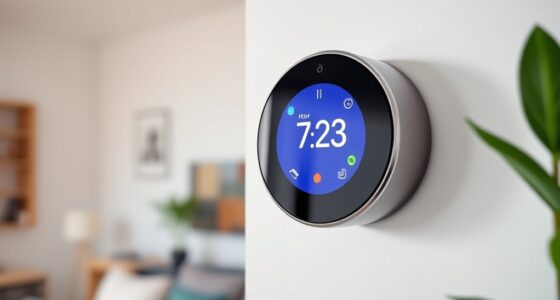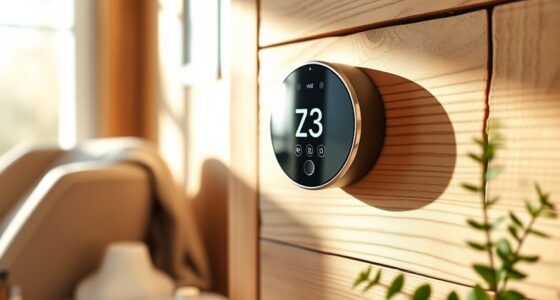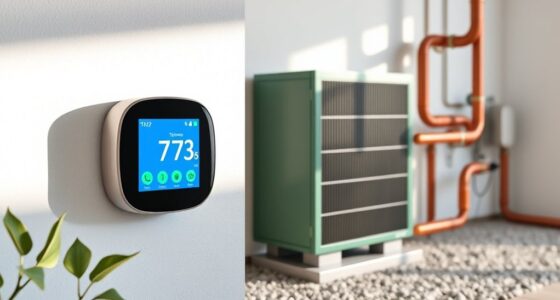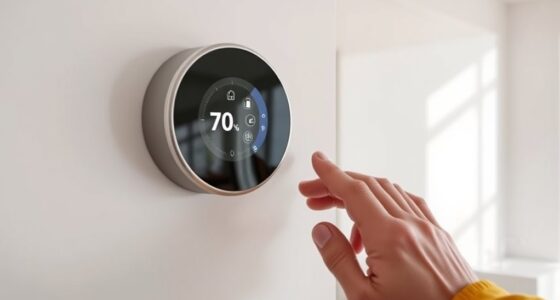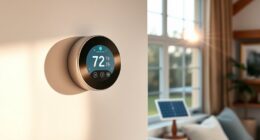If your programmable thermostat is outdated, unreliable, or lacks energy-saving features, it’s time to upgrade to a smart thermostat. Older models may no longer respond well or support the latest technology, leading to higher energy bills and inconvenience. A smart thermostat learns your habits, offers remote control, and improves efficiency. Keep in mind, upgrading can make your home more comfortable and eco-friendly—discover more about the best timing for your upgrade below.
Key Takeaways
- Your current thermostat is outdated, unreliable, or no longer supports updates or smart features.
- You want to improve energy efficiency and reduce utility bills through automated, optimized heating and cooling.
- You desire remote control and automation capabilities that programmable thermostats cannot provide.
- Your existing thermostat lacks compatibility with modern smart home systems and voice assistants.
- You’re interested in detailed energy usage reports and insights to further enhance savings and convenience.

Knowing when to upgrade your thermostat can save you money and improve your home’s comfort. If you’re still relying on a basic or even a programmable thermostat, it might be time to contemplate switching to a smart thermostat. The key benefit of upgrading is the potential for increased energy savings, which directly impacts your utility bills. Smart thermostats use advanced algorithms and learning capabilities to optimize your heating and cooling patterns, ensuring you don’t waste energy when you’re away or asleep. This not only reduces your environmental footprint but also puts more money back into your pocket over time.
Beyond energy savings, user convenience plays a significant role in determining when an upgrade makes sense. Programmable thermostats require you to set schedules manually, which can be a hassle if your routine changes frequently. Smart thermostats, on the other hand, learn your habits over time and adjust settings automatically, making your life easier. For example, if you typically leave for work at 8 a.m., a smart thermostat can recognize this pattern and start cooling or heating just before you leave, then save energy while you’re gone. You can also control your smart thermostat remotely through a smartphone app, giving you the ability to adjust the temperature from anywhere. This flexibility ensures your home remains comfortable without you having to remember to change settings manually.
Another indicator that it’s time for an upgrade is if your current thermostat doesn’t integrate well with other smart home devices. Modern smart thermostats can connect with voice assistants like Alexa or Google Assistant, allowing you to change settings with simple voice commands. If you find yourself frustrated by your current thermostat’s limitations or if it’s outdated and prone to malfunctions, upgrading can improve your overall home automation experience. Additionally, newer models often feature intuitive interfaces and more precise temperature controls, which contribute to a more comfortable environment and better energy management.
Finally, consider the age and functionality of your existing thermostat. If it’s over a decade old, chances are it lacks the smart features and energy-efficient technology available today. Upgrading can provide you with insights into your energy use through detailed reports, helping you identify further savings opportunities. When your current thermostat no longer supports updates or fails to respond reliably, it’s a clear sign that an upgrade isn’t just a luxury but a necessity for energy efficiency and user convenience. Reliable backup power solutions can also be crucial during power outages, ensuring your smart thermostat continues to operate seamlessly.
Frequently Asked Questions
Can a Smart Thermostat Reduce My Energy Bills Significantly?
Yes, a smart thermostat can considerably reduce your energy bills. It optimizes your heating and cooling schedules based on your habits, leading to greater energy savings. Plus, its adaptive features ensure you’re not wasting energy when you’re away or asleep. Over time, this makes smart thermostats a cost-effective choice, helping you cut down on utility costs while maintaining comfort. You’ll see the benefits in your monthly energy bills.
Is My Current Thermostat Compatible With Smart Home Systems?
Is your legacy thermostat ready to embrace the future? If you have a wired system, you’ll want to check compatibility with your smart home setup. Most smart thermostats support common wiring types, but some legacy models might require adapters or special wiring. To guarantee seamless integration, verify your thermostat’s wired compatibility and consult your smart home platform’s compatibility list. Don’t leave your home’s intelligence hanging—upgrade for smarter control!
How Difficult Is It to Install a Smart Thermostat Myself?
Installing a smart thermostat yourself is usually straightforward if you’re comfortable with DIY projects. You’ll need to check wiring compatibility beforehand, ensuring your current setup matches the thermostat’s requirements. Most models come with detailed instructions and plug-and-play features, making DIY installation manageable. However, if your wiring is complex or incompatible, you might want to contemplate professional help to avoid damaging your system or voiding warranties.
What Security Risks Are Associated With Smart Thermostats?
Smart thermostats can pose security risks like hacking vulnerabilities and privacy concerns. If you don’t update firmware regularly or use weak passwords, hackers could access your device and personal data. To protect yourself, choose strong, unique passwords, enable two-factor authentication, and keep your device’s software current. Being mindful of these risks helps you enjoy the convenience of smart thermostats without compromising your home’s security.
Do Smart Thermostats Work During Power Outages?
Smart thermostats generally don’t work during power outages unless they have backup power. Without it, you lose automatic control and must switch to manual control on your HVAC system. Some models offer backup batteries, but many rely on your home’s power supply. To guarantee continuous operation, consider a smart thermostat with backup power options, so you can maintain control even when the power’s out.
Conclusion
If you’re noticing inconsistent temperatures, rising energy bills, or struggling with your current thermostat’s features, it’s time to upgrade. Think of your thermostat as the brain of your home’s comfort system—upgrading from programmable to smart can be like moving from a flip phone to a smartphone. The investment pays off by saving energy and offering convenience. Don’t wait until discomfort or costs become unbearable—upgrade now and enjoy smarter, more efficient home climate control.


